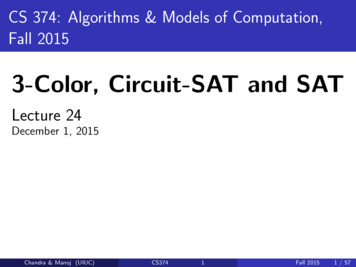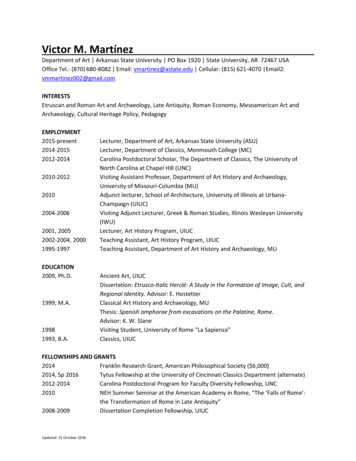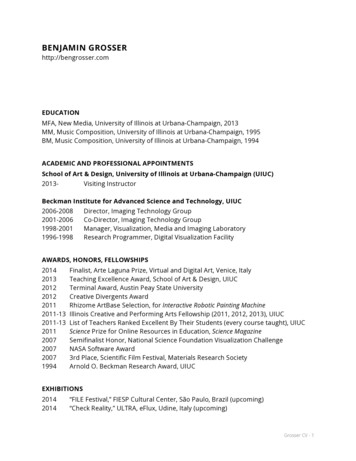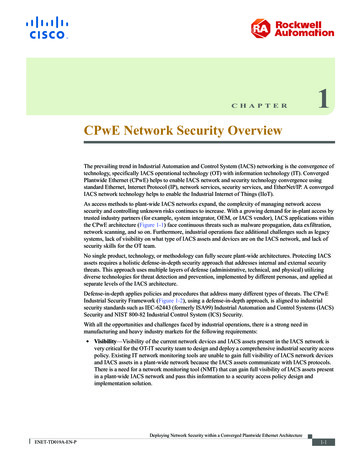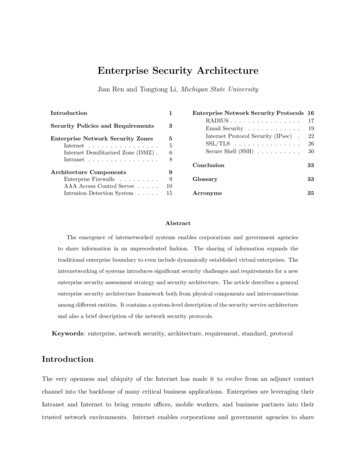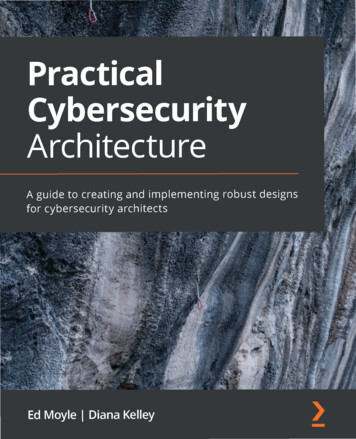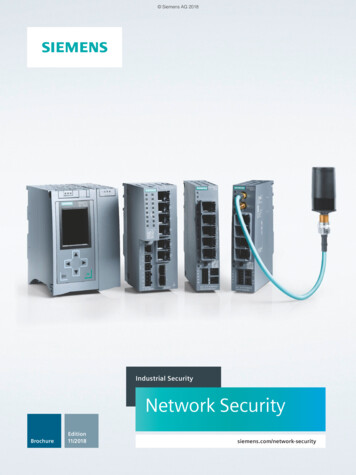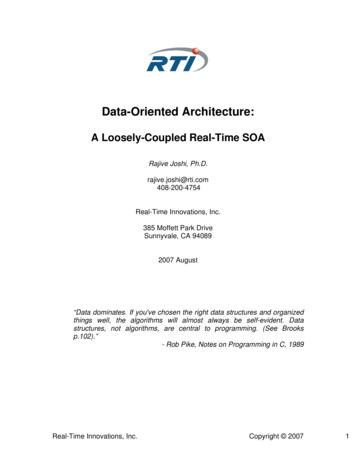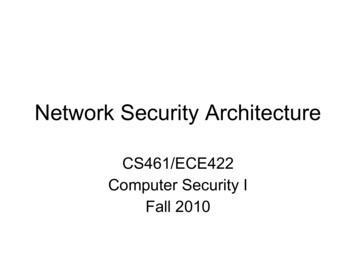
Transcription
Network Security ArchitectureCS461/ECE422Computer Security IFall 2010
Reading Material Computer Security chapter 26. “Firewalls and Internet Security: Repelling theWily Hacker”, Cheswick, Bellovin, and Rubin.– New second edition
Overview Network Security Architecture– Segmentation– Security Domains– VPN Firewall Technology– Address Translation– Denial of Service attacks Intrusion Detection Both firewalls and IDS are introductions.– Both are covered in more detail in the Security Lab class.– IDS is covered in more detail in 463 – Computer Security.
Segment Separate Functionality– Limit infection vectorsDesktop machines192.168.50.0Server192.168.50.100Runs DNS, SMTP,DB, Key Design App,File ServerOutsideWorld
Security olNetwork
Virtual Private Networks A private network that is configured withina public network A VPN “appears” to be dedicated networkto customer The customer is actually “sharing” trunksand other physical infrastructure with othercustomers Security?– Depends on implementing protocol
Multiple VPN Technologies SSLConfidentiality? YesData integrity? YesUser authentication? YesNetwork access control?NoIn addition, limited traffic IPSecConfidentiality? YesData Integrity? YesUser Authentication? YesNetwork access control?YesClient configurationrequired.VLAN – Layer 2 tunnellingtechnology Confidentiality? No Data Integrity? No User authentication? Yes Network access control?Yes Not viable over non-VLANinternetworks
Security Domains with rporateNetworkCoffeeShopPartnerNetwork
Firewall Goal Insert after the fact security by wrapping orinterposing a filter on network trafficInsideOutside
“Typical” corporate networkFirewallIntranetMail forwardingFile ServerWeb ServerMail serverDNS (internal)DemilitarizedZone (DMZ)DNS (DMZ)Web ServerFirewallUser machinesUserUsermachinesmachinesInternet
Application Proxy Firewall Firewall software runs in application space onthe firewall The traffic source must be aware of the proxyand add an additional header Leverage basic network stack functionality tosanitize application level traffic– Block java or active X– Filter out “bad” URLs– Ensure well formed protocols or block suspectaspects of protocol
Packet Filter Firewall Operates at Layer 3 in router or HW firewall Has access to the Layer 3 header and Layer 4header Can block traffic based on source and destinationaddress, ports, and protocol Does not reconstruct Layer 4 payload, so cannotdo reliable analysis of layer 4 or higher content
Stateful Packet Filters Evolved as packet filters aimed for proxy functionality In addition to Layer 3 reassembly, it can reconstruct layer 4traffic Some application layer analysis exists, e.g., for HTTP, FTP,H.323– Called context-based access control (CBAC) on IOS– Configured by fixup command on PIX Some of this analysis is necessary to enable addresstranslation and dynamic access for negotiated data channels Reconstruction and analysis can be expensive.– Must be configured on specified traffic streams– At a minimum the user must tell the Firewall what kind of trafficto expect on a port– Degree of reconstruction varies per platform, e.g. IOS does notdo IP reassembly
Traffic reconstructionXYFTP: X to YGET /etc/passwdGET command causesfirewall to dynamicallyopen data channel initiatefrom Y to XMight have filter for files toblock, like /etc/passwd
Access Control Lists (ACLs) Used to define traffic streams– Bind ACL’s to interface and action Access Control Entry (ACE) contains–––––Source addressDestination AddressProtocol, e.g., IP, TCP, UDP, ICMP, GRESource PortDestination Port ACL runtime lookup––––LinearN-dimensional tree lookup (PIX Turbo ACL)Object GroupsHW classification assists
Ingress and Egress Filtering Ingress filtering– Filter out packets from invalid addresses before entering yournetwork Egress filtering– Filter out packets from invalid addresses before leaving yournetworkOwns network XInsideOutsideEgress FilteringBlock outgoing traffic notsourced from network XIngress FilteringBlock incoming traffic fromone of the set of invalidnetworks
Denial of Service Example attacks– Smurf Attack– TCP SYN Attack– Teardrop DoS general exploits resourcelimitations– Denial by Consumption– Denial by Disruption– Denial by Reservation
Teardrop Attack Send series of fragments that don't fittogether– Poor stack implementations would crash– Early windows stacksOffset 0, len60Offset 30, len 90Offset 41, len 173
Address Translation Traditional NAT RFC 3022 Reference RFC Map real address to alias address– Real address associated with physical device, generally anunroutable address– Alias address generally a routeable associated with thetranslation device Originally motivated by limited access to publicly routableIP addresses– Folks didn’t want to pay for addresses and/or hassle with gettingofficial addresses Later folks said this also added security– By hiding structure of internal network– Obscuring access to internal machines Adds complexity to firewall technology– Must dig around in data stream to rewrite references to IPaddresses and ports– Limits how quickly new protocols can be firewalled
Address Hiding (NAPT) Many to few dynamic mapping– Packets from a large pool of private addresses aremapped to a small pool of public addresses at runtime Port remapping makes this sharing morescalable– Two real addresses can be rewritten to the same aliasaddress– Rewrite the source port to differentiate the streams Traffic must be initiated from the real side
NAT exampleHide from inside to outside192.168.1.0/24 behind 128.274.1.1Static map from inside to DMZ192.168.1.5 to 128.274.1.5192.168.1.0/24128.128.1.0/26Src 192.168.1.1Dst outsideInternetSrc 128.274.1.1Dst microsoft.com
Static Mapping One-to-one fixed mapping– One real address is mapped to one aliasaddress at configuration time– Traffic can be initiated from either side Used to statically map out small set ofservers from a network that is otherwisehidden Static port remapping is also available
NAT exampleHide from inside to outside192.168.1.0/24 behind 128.274.1.1Static map from inside to DMZ192.168.1.5 to 128.274.1.5192.168.1.0/24128.128.1.0/26Src 192.168.1.5Dst 10.10.10.1insideEnforcingDeviceDMZ10.10.10.0/24Src 128.274.1.5Dst 10.10.10.1outsideInternet
Intrusion Detection Holy Grail: Detect and correct “bad” systembehaviour Detection can be viewed in two parts– Anomaly detection: Use statistical techniques todetermine unusual behavior– Mis-use detection: Use signatures to determineoccurrence of known attacks Detection can be performed on host data(HIDS), network data (NIDS), or a hybrid of both
IDS Architecture Agents run at the lowest level gathering data. Performsome basic processing. Agents send data to a Director that performs moresignificant processing of the data. Potentially there is ahierarchy of agents and directors– Director has information from multiple sources and can performa time-based correlation to derive more significant actions Directors invoke Notifiers to perform some action inresponse to a detected attack––––Popup a window on a screenSend an email or a pageSend a new syslog message elsewhere.Adjust a firewall or some other policy to block future action fromthe attacker
Data Sources Direct data– Network packets– System calls Indirect data– Syslog data, Windows event logs– Events from other intrusion detection systems– Netflow information generated by routersabout network traffic
Mis-use/Signature Detection Fixed signatures are used in most deployed IDS products– E.g., Cisco, ISS, Snort Like virus scanners, part of the value of the product is theteam of people producing new signatures for newly observedmalevolent behavior The static signature mechanism has obvious problems in thata dedicated attacker can adjust his behaviour to avoidmatching the signature. The volume of signatures can result in many false positives– Must tune the IDS to match the characteristics of your network– E.g., what might be unusual in a network of Unix systems mightbe normal in a network of Windows Systems (or visa versa)– Can result in IDS tuned too low to miss real events– Can hide real attacks in the mass of false positives
Example Signature Signature for port sweep– A set of TCP packets attempting to connect toa sequence of ports on the same device in afixed amount of time In some environments, the admin mightrun nmap periodically to get an inventoryof what is on the network– You would not want to activate this signaturein that case
Anomaly/statistical detection Seems like using statistics will result in a more adaptableand self-tuning system– Statistics, neural networks, data mining, etc. How do you characterize normal?– Create training data from observing “good” runs E.g., Forrest’s program system call analysis– Use visualization to rely on your eyes How do you adjust to real changes in behaviour?– Gradual changes can be easily addressed. Gradually adjustexpected changes over time– Rapid changes can occur. E.g., different behaviour after workhours or changing to a work on the next project
Host Based IDS Tripwire – Very basic detection of changesto installed binaries More recent HIDS. Look at patterns ofactions of system calls, file activity, etc. topermit, deny, or query operations– Cisco Security Agent– Symantec– McAfee Entercept
Classical NIDS deploymentInsideOutsidePromiscuousInterfaceNIDS AgentManagementNIDS Director
NIDS Remediation Options Log the eventDrop the connectionReset the connectionChange the configuration of a nearbyrouter or firewall to block futureconnections
Intrusion Protection Systems (IPS) Another name for inline NIDS Latest buzz among the current NIDS vendors Requires very fast signature handling– Slow signature handling will not only miss attacks butit will also cause the delay of valid traffic– Specialized hardware required for high volumegateways When IDS is inline, the intrusion detector cantake direct steps to remediate. If you move IDS into the network processingpath, how is this different from really cleverfirewalling?
Network IPS scenarioInsideOutsideNIDS AgentNIDS Director
Honey Pots Reconnaissance for the good guys Deploy a fake system– Observe it being attacked Resource management– Cannot be completely passive Must provide enough information to keep attackerinterested– Must ensure that bait does not run away Scale– Host, network, dark address space
Summary Identification of security domains basis ofperimeter security control– Firewall is the main enforcer Intrusion detection introduces deeperanalysis and potential for more dynamicenforcement Intermediate enforcement can handlesome Denial of Service attacks
Intrusion Detection Holy Grail: Detect and correct "bad" system behaviour Detection can be viewed in two parts -Anomaly detection: Use statistical techniques to determine unusual behavior -Mis-use detection: Use signatures to determine occurrence of known attacks Detection can be performed on host data
